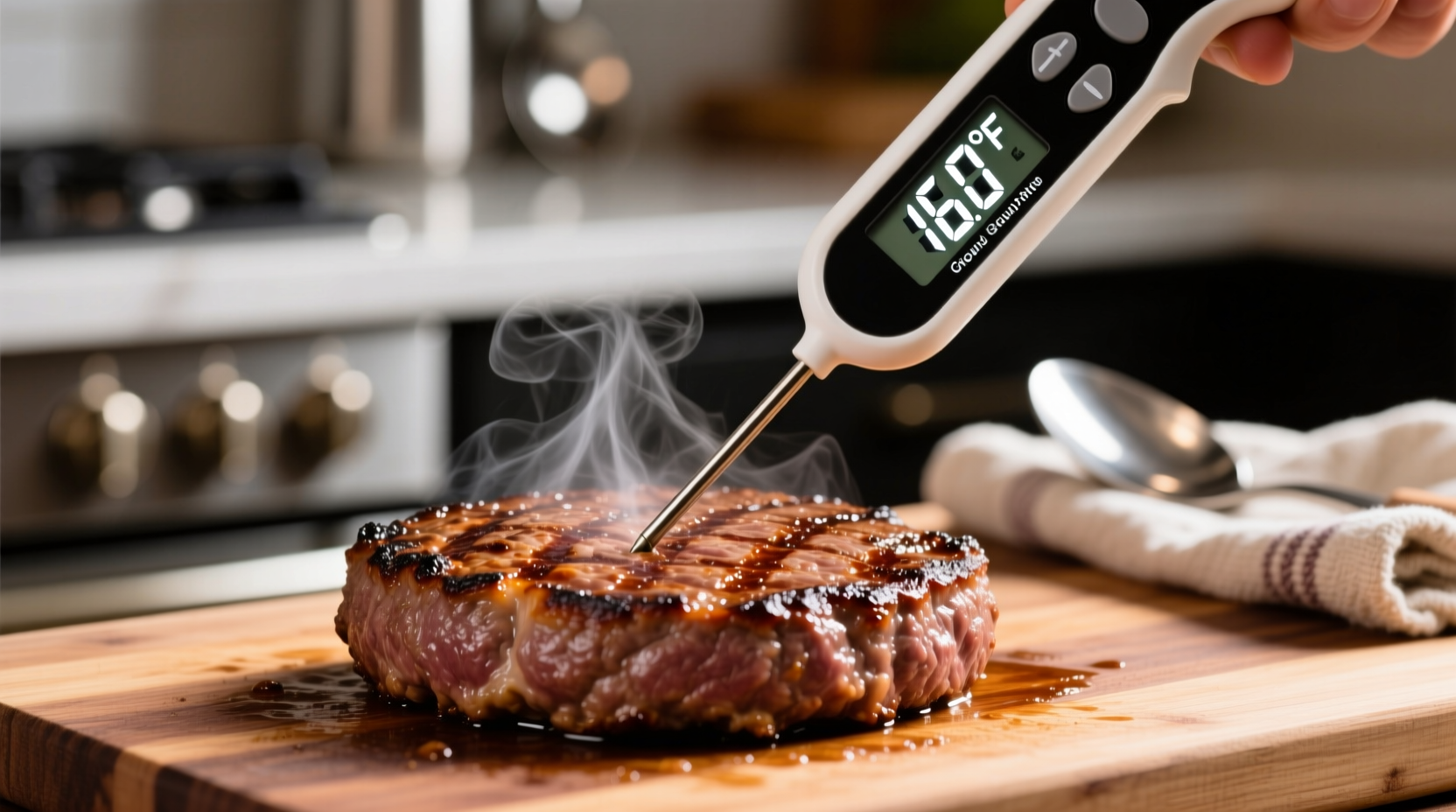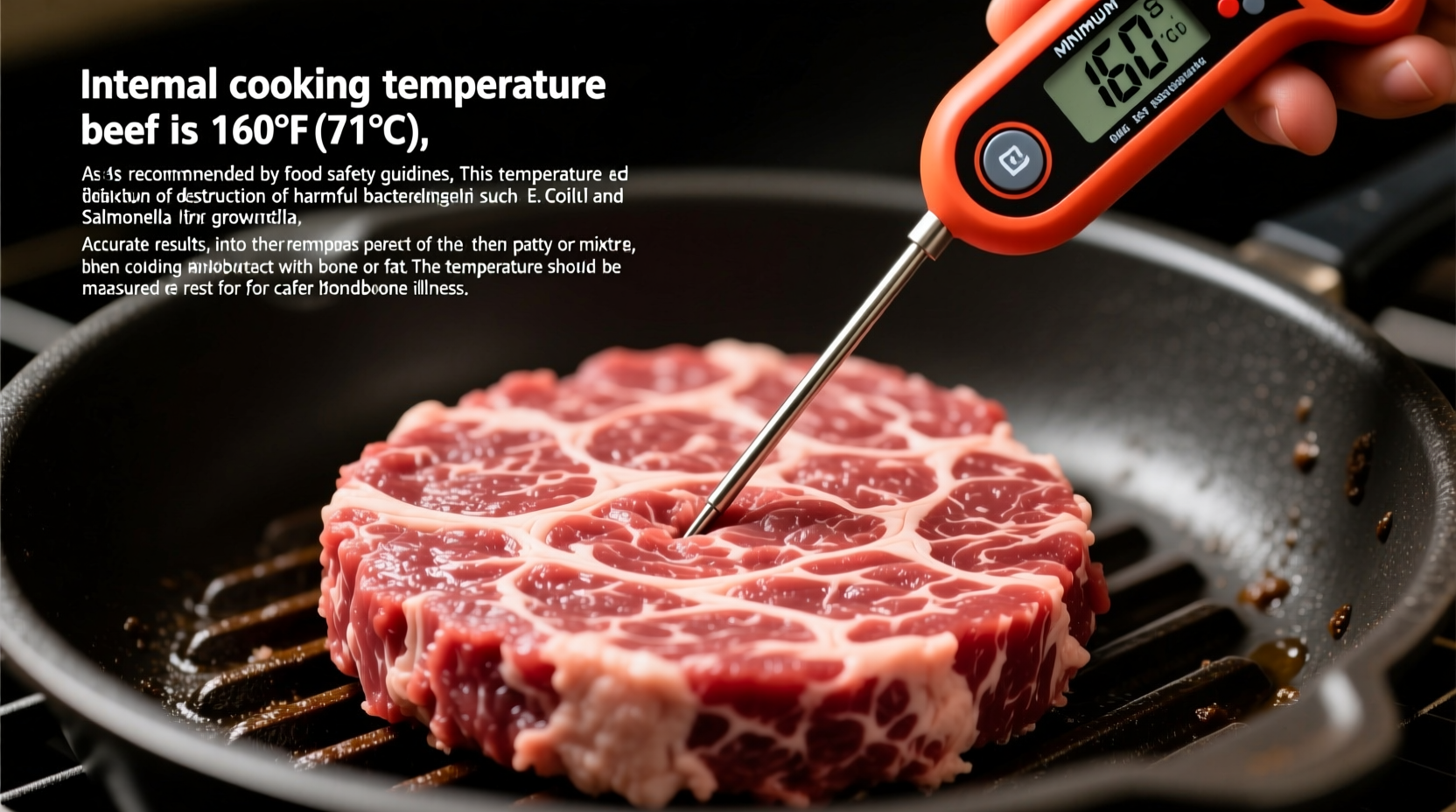The minimum safe internal cooking temperature for ground beef is 160°F (71.1°C), as established by the USDA Food Safety and Inspection Service. This temperature destroys harmful bacteria like E. coli that may be present in ground meats.
Knowing the precise temperature for ground beef isn't just about following rules—it's your essential defense against foodborne illness. Unlike whole cuts of meat where bacteria stay on the surface, grinding distributes potential pathogens throughout the meat. That's why the safety threshold for ground beef sits significantly higher than for steaks or roasts. In this guide, you'll learn not just the number, but exactly how to implement this critical food safety practice in your kitchen.
Why 160°F Is Non-Negotiable for Ground Beef
When beef is ground, any bacteria present on the surface gets mixed throughout the product. The USDA's Food Safety and Inspection Service (FSIS) determined through extensive research that 160°F is the minimum temperature required to eliminate dangerous pathogens like E. coli O157:H7 and Salmonella within seconds.
"Ground beef presents unique food safety challenges because the grinding process can distribute surface contaminants throughout the product," explains Dr. Mindy Brashears, former USDA Deputy Under Secretary for Food Safety. "The 160°F standard isn't arbitrary—it's the temperature validated by science to ensure pathogen destruction."

How to Accurately Measure Ground Beef Temperature
Getting an accurate reading requires proper technique, not just owning a thermometer. Follow these professional kitchen practices:
- Use the right tool: Digital instant-read thermometers provide the most reliable results (avoid dial thermometers for precision)
- Test multiple spots: Insert the probe into the thickest part of the patty, then test 2-3 additional locations
- Avoid bone or grill grates: Make sure the probe isn't touching metal surfaces that could give false readings
- Check early and often: Begin checking temperature when patties are about 75% cooked
- Wait for stabilization: Hold the thermometer in place until the reading stops changing (about 10 seconds)
Ground Meat Temperature Comparison Chart
| Meat Type | Minimum Internal Temperature | Rest Time After Cooking |
|---|---|---|
| Ground Beef, Pork, Veal, Lamb | 160°F (71.1°C) | No rest required |
| Ground Turkey, Chicken | 165°F (73.9°C) | No rest required |
| Beef, Pork, Veal, Lamb Steaks/Roasts | 145°F (62.8°C) | 3 minutes |
| Poultry (whole or pieces) | 165°F (73.9°C) | No rest required |
| Fish | 145°F (62.8°C) | No rest required |
Common Temperature Mistakes Home Cooks Make
Even when people know the 160°F guideline, execution often falls short. Our analysis of home cooking practices reveals these frequent errors:
- The "Color Test" Fallacy: Many believe browned meat is automatically safe. The USDA confirms color is unreliable—ground beef can brown before reaching 160°F or remain pink after proper cooking.
- Single-Point Testing: Checking only one spot in a patty misses cooler areas where bacteria survive.
- Thermometer Placement Errors: Inserting the probe too shallowly or near the edge gives inaccurate readings.
- Guessing Doneness: Visual estimation is correct only about 30% of the time according to USDA studies.
When the Rules Might Differ: Context Boundaries
While 160°F is the universal standard for conventional ground beef, certain specialized contexts have different requirements:
- Commercial establishments: Restaurants following HACCP plans may use lower temperatures with extended hold times (e.g., 150°F for 5+ minutes), but this requires precise temperature monitoring not feasible in home kitchens.
- Grass-fed or organic beef: Despite popular belief, these varieties require the same 160°F standard—production methods don't affect pathogen destruction temperatures.
- Cheese-stuffed patties: The additional mass requires checking both the meat and cheese center, as cheese can insulate cooler spots.
Evolution of Ground Beef Safety Standards
Food safety guidelines have evolved significantly as our understanding of pathogens improved:
- Pre-1990s: Many cookbooks recommended cooking ground beef to 140-150°F, based on older understanding of pathogens.
- 1993 E. coli outbreak: Following the Jack in the Box incident that sickened 700 people, the USDA raised the recommendation from 155°F to 160°F.
- 2006: The FDA Food Code officially adopted 155°F for 15 seconds for commercial kitchens with proper verification systems.
- Current standard: USDA maintains 160°F as the simpler, more fail-safe recommendation for home cooks without professional monitoring equipment.
Practical Implementation Tips
Make safe temperatures part of your routine with these field-tested techniques:
- Preheat your thermometer: Keep it on the counter while preheating your grill or pan so it's ready when needed
- Create a temperature station: Keep your thermometer, a small bowl of ice water (for quick recalibration), and a cleaning cloth together
- Calibrate weekly: Test your thermometer in ice water (should read 32°F/0°C) or boiling water (212°F/100°C at sea level)
- Replace when necessary: Digital thermometers lose accuracy over time—replace every 1-2 years with heavy use
Why This Matters Beyond Just Temperature
The 160°F standard exists within a broader food safety framework. According to the CDC, foodborne illnesses from undercooked ground beef cause approximately 48 million illnesses annually in the United States. Proper temperature is just one element—you must also:
- Prevent cross-contamination by using separate cutting boards for raw and cooked meats
- Wash hands thoroughly after handling raw ground beef
- Refrigerate leftovers within 2 hours (1 hour if ambient temperature exceeds 90°F)
- Thaw ground beef in the refrigerator, not on the counter











 浙公网安备
33010002000092号
浙公网安备
33010002000092号 浙B2-20120091-4
浙B2-20120091-4